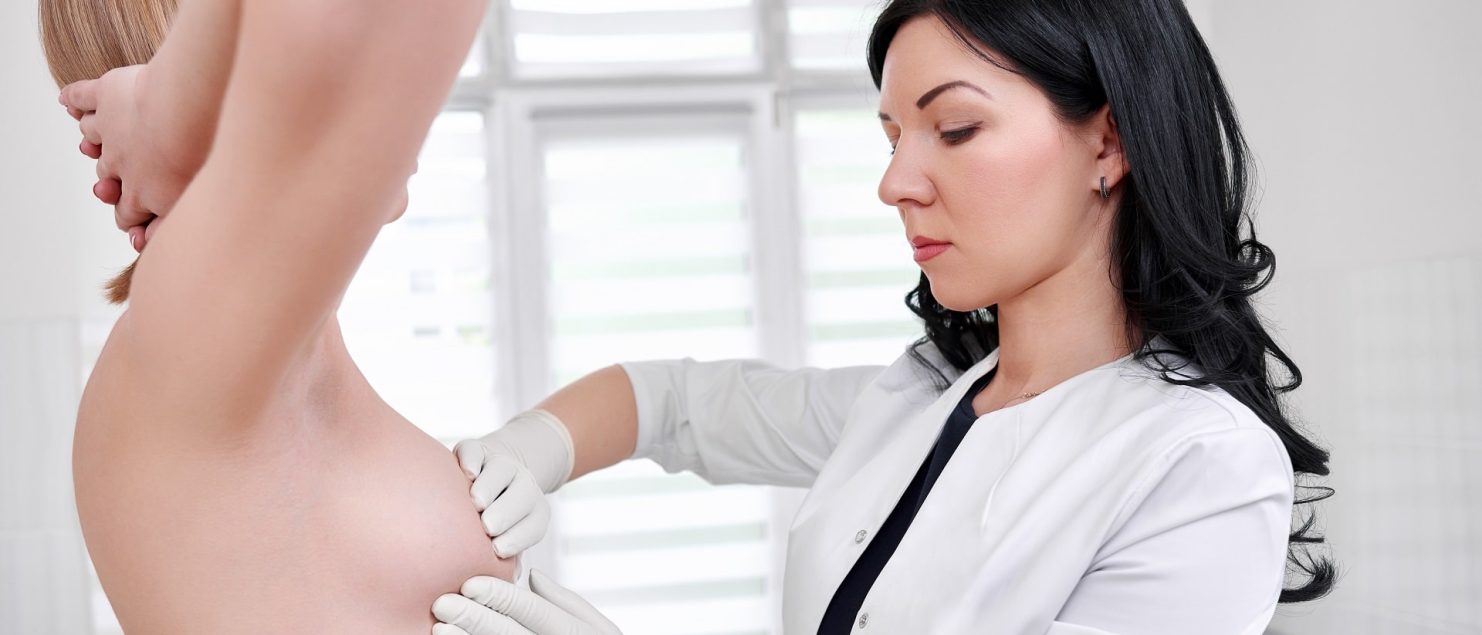Profilaktyka raka piersi – objawy, czynniki ryzyka, diagnostyka
Na temat raka piersi słyszałaś pewnie już wiele. Wiesz, że należy regularnie badać piersi, więc gdy lekarz skieruje Cię na USG nie protestujesz. Raczej nie wykonujesz badań regularnie, bo przecież nie masz na to czasu. Jeśli już trafisz do gabinetu, wychodzisz z niego z ulgą, bo wyniki są perfekcyjne. Ale… co by było gdyby?
Nie czekaj aż zauważysz guzek lub poczujesz nieokreślony ból. Lepiej zapobiegać niż leczyć! Sprawdź co powinnaś wiedzieć na temat profilaktyki raka piersi.
Na czym polega profilaktyka raka piersi?
Profilaktyka to z definicji zapobieganie. W tym przypadku jest to działanie w celu zapobiegania wystąpieniu niebezpiecznych zmian w twoich piersiach. Profilaktyka raka piersi opiera się na badaniach przesiewowych, które umożliwiają wykrycie nawet najmniejszych zmian zanim odczujesz jakiekolwiek objawy.
Dlaczego powinno zależeć Ci na czasie? Samobadanie piersi, choć tak ważne, nie jest skuteczne we wczesnym etapie tworzenia się guzka czy zmiany. Możesz go po prostu nie wyczuć. W badaniu mammografem 3D wykryta może zostać już bardzo niewielka zmiana w piersi, różnego pochodzenia. Nawet jeśli wykryta zmiana będzie mieć charakter nowotworowy, ale małych rozmiarów, znacznie zwiększa się prawdopodobieństwo wyleczenia.
Jakie są czynniki ryzyka wystąpienia raka
Wiek
Najwięcej zachorowań na raka piersi spotyka kobiety po 50 roku życia. Twoja czujność powinna więc rosnąć wraz z wiekiem.
Obciążenie genetyczne
Nowotwór piersi możesz odziedziczyć (około 10% przypadków). Prawdopodobieństwo zachorowania rośnie gdy zachorują twoje krewne pierwszego stopnia (matka, siostra, córka). W celu określenia ryzyka dziedzicznego wystąpienia raka piersi możesz zbadać mutację genów BRCA1 oraz BRCA2. Najpewniejszym kryterium wystąpienia dziedzicznego raka piersi jest stwierdzenie mutacji genów. U kobiet z mutacją genów BRCA życiowe ryzyko wystąpienia raka piersi wynosi 80%.
Czynniki związane z rozrodczością
Ryzyko zachorowania zwiększa się również u kobiet, które wcześniej osiągnęły dojrzałość płciową oraz późno przeszły menopauzę. Nie bez znaczenia jest też macierzyństwo. Większym ryzykiem obciążone są kobiety, które nie rodziły lub zostały mamami późno – po 35 roku życia.
Czynniki egzogeniczne
Są to czynniki zewnętrzne, czyli przede wszystkim hormonalne środki antykoncepcyjne, hormonalna terapia zastępcza (HTZ) trwająca dłużej niż 10 lat.
Styl życia
Na ryzyko rozwoju nowotworu piersi może wpłynąć zawartość twojego talerza. Rośnie, gdy spożywasz duże ilości tłuszczów nasyconych oraz pijesz alkohol. Otyłość zwiększa ryzyko zachorowania na nowotwór oraz utrudnia jego wykrycie, ze względu na grubość tkanki tłuszczowej.
Zmiany łagodne
Nie trać czujności jeśli zmiana w piersi okaże się być łagodna. Nawet niegroźne zmiany mogą powodować wzrost ryzyka zachorowania na nowotwór.
Objawy raka piersi
Objawem, na który powinnaś zwrócić uwagę, pojawiającym się najwcześniej i niedającym dolegliwości bólowych jest guz umiejscowiony zwykle w górnej bocznej części piersi.
O raku piersi może świadczyć również:
- wciągnięcie brodawki,
- asymetria sutków,
- owrzodzenie brodawki lub skóry piersi,
- dodatkowe guzki w okolicy,
- ból bez uchwytnych przyczyn,
- świąd lub pieczenie brodawki,
- wyciek płynu z brodawki,
- niewielkie pogrubienie skóry.
W wielu przypadkach, wraz z rozwojem raka, powiększają się węzły chłonne zlokalizowane pod pachą, a następnie węzły szyjno-nadobojczykowe. Jeśli rak ma charakter tzw. zapalny, jego objawem jest obrzęk skórny, który szybko narasta, zaczerwienienie i ocieplenie skóry lub bolesność.
Profilaktyka raka piersi
Samobadanie piersi
Pierwszym i podstawowym badaniem, którego nawyk powinnaś w sobie wyrobić jest samobadanie piersi. Zacznij jak najwcześniej, samobadanie powinno się wykonywać nawet już od 20 roku życia.
Kontrolę piersi powinnaś wykonywać zawsze tydzień po okresie (samobadanie, USG, mammografię). Wahania hormonalne sprawiają, że przed miesiączką oraz w czasie jej trwania piersi mogą być opuchnięte i nadwrażliwe.
Aby przeprowadzić samobadanie wykonaj kilka poniższych czynności:
- Stań przed lustrem, unieś wysoko do góry ręce i sprawdź, czy nie widzisz zmian w kształcie piesi, czy nie widać przebarwień, czy skóra nie marszczy się lub nie jest nadmiernie napięta.
- Ułóż ręce na biodrach i również sprawdź, czy nie widzisz powyższych zmian.
- Sprawdź, czy naciskając brodawkę nie pojawi się płyn.
- Badanie wykonaj pod prysznicem. Załóż jedną rękę z tyłu głowy, drugą natomiast kontroluj pierś. Zataczaj lekko trzema środkowymi palcami koliste ruchy wzdłuż piersi, z góry i w dół, i z powrotem. Czynności te powtórz trzymając rękę wzdłuż tułowia.
Badanie mammograficzne
Mammografia to zdjęcie radiologiczne piersi umożliwiające wykrywanie małych, niewyczuwalnych ręką zmian nowotworowych. Jej czułość ocenia się na 80-90%. Uznana za najlepszy sposób wykrywania wczesnego raka sutka u kobiet powyżej 40 r. ż.
Obecnie mammografię wykonuje się w zaawansowanym systemie cyfrowym, co zdecydowanie zwiększa precyzję obrazowania i umożliwia powiększanie dowolnych fragmentów w celu dokładniejszej analizy. Szczególnie precyzyjne i niezawodne jest badanie mammograficzne 3D z funkcją tomosyntezy, polegające na trójwymiarowym obrazowaniu piersi. Skuteczne jest nawet w trudnych przypadkach diagnostycznych, w badaniu piersi z dużą ilością tkanki gruczołowo-włóknistej.
Dzięki mammografii dowiesz się jakie jest prawdopodobieństwo raka w przypadku rozpoznanej zmiany. Badanie umożliwi wybranie sposobu dalszego postępowania.

Diagnostyka raka piersi
Do najważniejszych metod diagnostycznych raka piersi należą:
- mammografia (MM),
- ultrasonografia (USG),
- mammografia metodą rezonansu magnetycznego (MR),
- biopsja aspiracyjna cienkoigłowa (BACC) – pobranie cienką igłą komórek do badania histopatologicznego, pod kontrolą USG,
- biopsja gruboigłowa – pobranie grubszą igłą cienkiego skrawka tkanki chorobowo zmienionej do badania histopatologicznego, pod kontrolą USG,
- wycinek chirurgiczny,
- badanie komórek wydzieliny z brodawki sutkowej.

